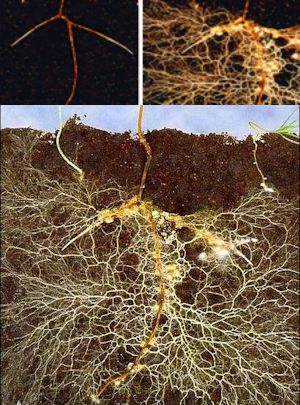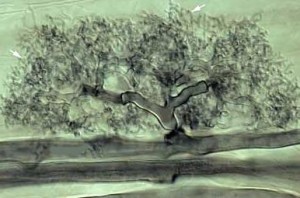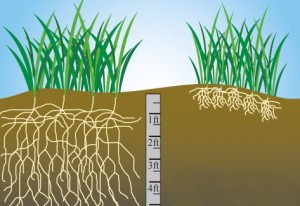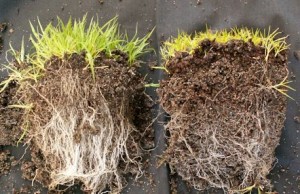The Biggest Helper for Lawn and Garden Plants

Untreated roots at top left. Inoculated roots – top right and bottom. This can increase the surface absorbing area of plant roots 100 to 1,000 times.
Imagine a garden product that could greatly improve the ability of a plant to absorb nutrients and water from the soil — while improving the soil structure and biology. And, it could also network together your garden plants — or the grass plants in your lawn. Your stronger plants would start working as a team, helping each other rather than growing independently — or even competing against each other.
Welcome to the world of mycorrhizal fungi. The word “mycorrhiza” comes from the Greek language and literally means “fungus roots.” Hundreds of millions of years ago, long before the dinosaurs, mycorrhizal fungi provided the helping hand plants needed to grow out of the water and survive on dry land. Since then, mycorrhizal fungi have been the primary means by which 95% of the plants growing throughout the world get water and nutrients from the soil.
Plants absorb CO2 from the air and convert the carbon into sugars. They allow some of these sugars to pass through their roots into fungal mycelium to feed the fungus. The mycelium is the vegetative, branching, filamentous part of a fungus that penetrates into plant roots. In return, the fungi extract water and nutrients from soil and rocks and transfer them to the host plant, also via the mycellium. Like gardeners and farmers, mycorrhizal fungi help to feed and water plants. And like gardeners and farmers, they live off of their harvest from these crops.
Mycorrhizal mycelium also form a network for nutrient transfer.
Plants not only use mycelium to obtain nutrients, but also to pass nutrients and chemical messages to other plants in the area. Research has found that large trees in a forest feed young seedlings by passing nutrients and sugars through the mycelium network. Plants under attack by insects or diseases also use this network to send chemical warning signals to other plants so they can beef up their defense systems. Since the network of mycelium can cover a very large area, the chemical messages sent from the plants can travel very far — and quickly. This is why mycorrhizal fungi are now being called Nature’s Internet.
Gardeners and farmers all around the world are beginning to appreciate the benefits of teaming up with these fungi to produce healthier crops and better yields. Although plants can grow without mycorrhizal fungi, they grow much better with them. Plants with mycorrhizal fungi grow especially better in less than ideal environments, such as urban areas and home gardens. Mycorrhizal fungi help reduce stress and boost a plant’s immune system.
Unfortunately, common gardening methods today negatively affect these delicate, threadlike, mycorrhizal fungi. The use of chemical fertilizers, fungicides, tilling, and hoeing can disrupt or even destroy the mycorrhizal fungi normally found in soil. Letting gardens lie fallow during the winter starves the fungi by removing their food source. This is why winter cover crops have become so popular — they continue to feed the soil biology until crops are planted in spring. Mycorrhizal fungi are so important to plants, perennial plants continue to feed them out of their own food stores, even during their winter dormancy.

This is a microscopic picture taken inside the cell of a plant root. The fungal tree-like structure is where the plant and fungus exchange nutrients.
Our home garden soils today usually lack the mycorrhizal fungi needed to truly benefit our plants. With the use of soil-less mixes, most garden plants purchased also lack the important mycorrhizal fungi growing on their roots.
However, the good news is that you can increase the growth of mycorrhizal fungi and get them to work more efficiently with a mycorrhizal fungi root inoculant.
Or you can buy plants that have been inoculated with many beneficial microbes — like ours.
We are now inoculating our transplants with mycorrhizal fungi, along with many other microbes, so they will already be established on the roots of our transplants when you plant them.
Our Mycorrhizal Inoculum
Our mycorrhizal inoculum consists of 4 carefully selected species of endomycorrhizae. About 80% of the world’s plant species join with these types of mycorrhizae. It is also highly concentrated. We sell a ¼ lb. bag containing 15,000 propagules for $19.95.
Application
Our mycorrhizal inoculum can be banded under seed, placed under cuttings, or sprinkled on roots at transplant time. The goal is to create physical contact between the roots and the inoculant. This product can be used to inoculate roots of most agricultural crops.
For lawns — Apply during new seeding, overseeding, or aerification of turf. Use .25 lb. per 1000 sq. ft. You can use less — it will just take longer to fill in. It can be drilled in or spread with seed in turf grass. We mixed it in with our grass seed and let it sit overnight.
For transplanting — Apply product directly in contact with the roots. We just dip our plant roots in the inoculum to get good contact and quick germination of spores — and save money.
For planting seeds — Apply beneath the seed at rate of 1 tbls per row foot or 2 tbls per square foot.
To inoculate seed starting soil, mix in with seed starting media at 2 lbs per cubic yard.
Active Ingredients– Glomus Intraradices, G. Mosseae, G. Aggregatum, G. Etunicatum
Product can be stored in a cool dry place (Less than 140°F) without loss of viability.
How to Get Your Summer Garden off to a Faster Start.
Inexperienced gardeners think that planting summer veggies (tomatoes, etc) early means a better garden. I often hear people say they planted early and the plants didn’t die from frost damage. Actually planting summer veggies into cold soil that is not prepared properly is one of the biggest mistakes you can make. It doesn’t kill the plants but it damages the root system to where it takes weeks just to get the plants back to where they were when you planted.
People always wonder why we can plant so late and yet have plants bigger than what they planted a month earlier. It is because we plant into soil that is ready for planting — and we don’t damage the plant roots when we plant them. Here is one way we speed up plant growth next month.
After dipping them in our mycorrhizal inoculant, we have already started planting onions and shallots into areas that we will later be planting with other plants like tomatoes and peppers. The onions are very good at feeding mycorrhizal fungi and, over the next month, they will establish a stronger mycorrhizal network for other vegetables to tap into. This gets the other veggies off to a better, faster start since they already have an established root system to grow into.
Toughening Up Your Lawn
This past week, Barb and I decided to toughen up our lawn even more.
After cutting it, we raked it thoroughly, then fertilized and overseeded with our Turf Fescue Plus grass seed that we inoculated with our mycorrhizal fungi spores.
Turf-type tall fescue roots can reach down over 4 feet for water and nutrients compared with bluegrass, ryegrass and other fescues — which can only reach several inches into the soil.
We have not watered our lawn for several years now and decided to incorporate turf fescues into the lawn for even better drought resistance.
Mycorrhizal inoculant will extend the grass roots deeper, improve the soil structure, and join the lawn plants together for easier maintenance and less watering. Healthy soil and soil biology are the only way to eventually eliminate weeds and create a tougher lawn.
Using Turf-type tall fescue grass seed and mycorrhizal inoculant can dramatically improve the health of your lawn, helping it to crowd out weeds, while also reducing maintenance.
If you want to go a step farther towards a low maintenance lawn, overseed it with clover. Clover and turfgrass form a very low maintenance lawn because they effectively supply important needs of each other through the mycorrhizal network. Clover fixes nitrogen from the air and sends it to grass plants. Grass plants help to supply phosphorous that clover needs. This is why grass seed blends contained clover seed even into the 1980’s. Then, clever marketing convinced us that clover was a weed and needed to be eradicated. This was an environmental disaster as it opened up the floodgates for increased lawn care spending with increased fertilizer needs, widespread herbicide use — and huge ecological problems.
Turf-type tall fescue grass has a slightly different appearance than bluegrass or ryegrass. It is shorter and wider bladed so it is best to overseed the entire lawn or start a new lawn with it. Using it to fill bare spots could give your lawn a patchwork appearance. Turf Fescue Plus grass seed has a small amount of a matching bluegrass variety in it. Since turf fescues are clumping grasses, the bluegrass is included to fill in small bare spots.
Now is the time for fertilizing with one of our premium organic lawn fertilizers and also for overseeding — if you haven’t done this already. Overseeding is an important part of growing a healthy, lush lawn. While fertilizing your lawn is important, grass plants become less vigorous after a few years. Over time, lawns that have not been overseeded will grow thin and unhealthy, making it much easier for weeds to compete.
We choose the grass seed we sell and use carefully because the quality of the seed will greatly influence the appearance and maintenance of your lawn for many years. Avoid selecting “common” bluegrass or ryegrass, or inferior grade tall fescue. Though these are cheaper to buy, they do not have the lawn quality of newer turfgrass varieties and “turf-type” tall fescues.


